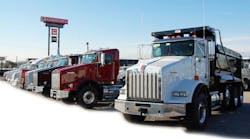The fourth-quarter 2013 Business Expectations Survey released by consulting firm Transport Capital Partners (TCP) indicates that in the next 12 months a “large majority of carriers” expect to increase capacity with “many moving to replace their aging vehicles.”
According to TCP, carriers are now being compelled both to add capacity and hike driver pay because the Hours-of-Service (HOS) rules that went into effect last year have cut down hours-per-day utilization of equipment.
Indeed, John Larkin, managing director & head of transportation capital markets research for Stifel, Nicolaus & Co., recently advised that a survey on the impact of HOS changes showed 80% of truckload carriers experiencing a loss of productivity and 67% of truck drivers a drop in wages.
And per Rick Schweitzer, general counsel of the National Private Truck Council, results of an NPTC membership survey conducted just a few months after the HOS changes became law revealed even then of 10 fleets responding: Nine reported being “adversely affected” by the rule changes; eight said their productivity had declined; and six reported they’d begun paying drivers for rest breaks.
Of particular significance, TCP pointed out that the number of carriers indicating they will not add capacity has indeed been trending down-- to where it now stands at its lowest level yet for this survey (27%).
What’s more-- and for the time ever in the TCP survey-- 30% of the carriers reported they expect to up capacity between 6% and 10%.
“These results are not surprising,” states TCP partner Richard Mikes, “given that 78% of the carriers this quarter indicated they had lost productivity due to HOS changes.”
Composite data, as reported by FleetOwner, indicates as many as 270,000 Class 6-8 trucks will be sold in 2014 with another increase expected in 2015.
In the TCP survey, larger carriers (over $25 million) expect to add equipment more aggressively than smaller ones (under $25 million).
Of the larger carriers, 39% expect to add between 5% and 15%-- compared with only 27% of smaller carriers that plan to do so.
Among those intending to add capacity, the percentage of carriers planning to do so through the use of independent contractors has soared 63% (from 16% to 26%).
Yet the most commonly reported method for adding capacity will be by attaining company equipment that is either financed or purchased via a TRAC Lease-- this activity is now at 35%, up from 26% in last quarter’s survey.
And worth noting is that the number of carriers reporting they will add capacity by purchasing other carriers has increased from exactly 0% three quarters ago to 6%.
According to TCP, as carriers boost capacity, they are also more likely to replace their older vehicles. Almost 40% expect to replace 11% to 25% of their fleet this year.
The difference between smaller and larger carriers is “striking,” the firm noted. Of smaller carriers, 77% plan to replace less than 10% of their fleet compared with 40% of larger carriers— “still a high number.”
Conversely, almost three times as many larger carriers expect to add 11% to 25% (50% vs. 15%).
“We suspect that all the 2007 ‘pre-buy’ tractors are [now] being traded out,” pointed out TCP's Mikes.
“If smaller carriers are not able to replace older, less fuel-efficient equipment-- and their higher maintenance costs-- those carriers will not be well positioned to benefit from looming good times,” Mikes cautioned.
To view graphs from the TCP Q4 survey, click here.
The next TCP Business Expectations Survey will launch in February. Motor carriers interested in participating in it may go to transportcap.com/industry-survey for more information.



